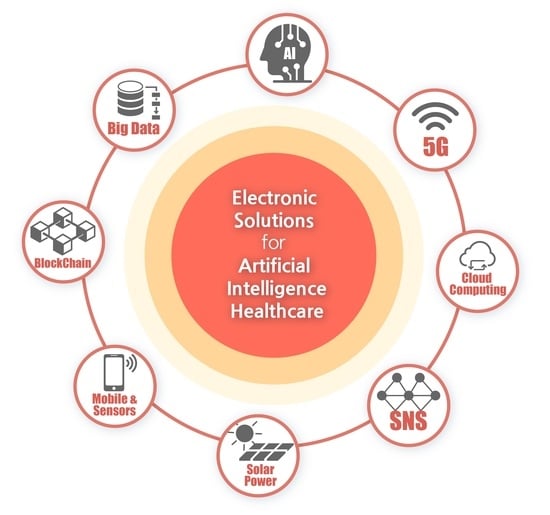Electronic Solutions for Artificial Intelligence Healthcare
1. Introduction
- -
- Electronic services respecting human beings and their lives.
- -
- Electronic solutions to artificial intelligence and Big Data.
- -
- Means of aiding and serving neglected people such as the disabled or elderly.
- -
- Electronic engineering mathematical theories that deeply affect science and industry.
- -
- Intelligent media techniques and services for systems engineering.
- -
- A public electronic engineering integration system for the future systems.
2. Review Papers
3. Research Papers
4. Conclusion and Future Special Issue
Funding
Conflicts of Interest
References
- Huh, J.H. Special Issue “Electronic Solutions for Artificial Intelligence Healthcare”. Available online: https://www.mdpi.com/journal/electronics/special_issues/AI_Healthcare (accessed on 14 September 2021).
- Zubaydi, H.D.; Chong, Y.W.; Ko, K.; Hanshi, S.M.; Karuppayah, S. A review on the role of blockchain technology in the healthcare domain. Electronics 2019, 8, 679. [Google Scholar] [CrossRef] [Green Version]
- Ponciano, V.; Pires, I.M.; Ribeiro, F.R.; Marques, G.; Garcia, N.M.; Pombo, N.; Zdravevski, E. Is The Timed-Up and Go Test Feasible in Mobile Devices? A Systematic Review. Electronics 2020, 9, 528. [Google Scholar] [CrossRef] [Green Version]
- Kim, M.; Moon, J.; Won, D.; Park, N. Revisit of password-authenticated key exchange protocol for healthcare support wireless communication. Electronics 2020, 9, 733. [Google Scholar] [CrossRef]
- Ponciano, V.; Pires, I.M.; Ribeiro, F.R.; Marques, G.; Villasana, M.V.; Garcia, N.M.; Spinsante, S. Identification of Diseases Based on the Use of Inertial Sensors: A Systematic Review. Electronics 2020, 9, 778. [Google Scholar] [CrossRef]
- Ko, J.S.; Huh, J.H.; Kim, J.C. Overview of maximum power point tracking methods for PV system in micro grid. Electronics 2020, 9, 816. [Google Scholar] [CrossRef]
- Pires, I.M.; Garcia, N.M.; Zdravevski, E. Measurement of Results of Functional Reach Test with Sensors: A Systematic Review. Electronics 2020, 9, 1078. [Google Scholar] [CrossRef]
- Pires, I.M.; Ponciano, V.; Garcia, N.M.; Zdravevski, E. Analysis of the Results of Heel-Rise Test with Sensors: A Systematic Review. Electronics 2020, 9, 1154. [Google Scholar] [CrossRef]
- Rehman, I.U.; Nasralla, M.M.; Philip, N.Y. Multilayer perceptron neural network-based QoS-aware, content-aware and device-aware QoE prediction model: A proposed prediction model for medical ultrasound streaming over small cell networks. Electronics 2019, 8, 194. [Google Scholar] [CrossRef] [Green Version]
- Hussain, G.; Jabbar, M.S.; Cho, J.D.; Bae, S. Indoor positioning system: A new approach based on lstm and two stage activity classification. Electronics 2019, 8, 375. [Google Scholar] [CrossRef] [Green Version]
- Lomaliza, J.P.; Park, H. Improved heart-rate measurement from mobile face videos. Electronics 2019, 8, 663. [Google Scholar] [CrossRef] [Green Version]
- Park, N.; Kim, B.G.; Kim, J. A Mechanism of Masking Identification Information regarding Moving Objects Recorded on Visual Surveillance Systems by Differentially Implementing Access Permission. Electronics 2019, 8, 735. [Google Scholar] [CrossRef] [Green Version]
- Li, S.; Jang, S.; Sung, Y. Melody extraction and encoding method for generating healthcare music automatically. Electronics 2019, 8, 1250. [Google Scholar] [CrossRef] [Green Version]
- Baldoumas, G.; Peschos, D.; Tatsis, G.; Chronopoulos, S.K.; Christofilakis, V.; Kostarakis, P.; Naka, K.K. A prototype photoplethysmography electronic device that distinguishes congestive heart failure from healthy individuals by applying natural time analysis. Electronics 2019, 8, 1288. [Google Scholar] [CrossRef] [Green Version]
- Jang, Y.; Park, C.H.; Seo, Y.S. Fake news analysis modeling using quote retweet. Electronics 2019, 8, 1377. [Google Scholar] [CrossRef] [Green Version]
- Yang, Z.; Leng, L.; Kim, B.G. StoolNet for color classification of stool medical images. Electronics 2019, 8, 1464. [Google Scholar] [CrossRef] [Green Version]
- Alzubaidi, L.; Fadhel, M.A.; Al-Shamma, O.; Zhang, J.; Duan, Y. Deep learning models for classification of red blood cells in microscopy images to aid in sickle cell anemia diagnosis. Electronics 2020, 9, 427. [Google Scholar] [CrossRef] [Green Version]
- Park, S.W.; Huh, J.H.; Kim, J.C. BEGAN v3: Avoiding mode collapse in GANs using variational inference. Electronics 2020, 9, 688. [Google Scholar] [CrossRef] [Green Version]
- Park, S.Y.; Yun, D.Y.; Kim, T.; Lee, J.Y.; Lee, D. An Energy Efficient Enhanced Dual-Fuzzy Logic Routing Protocol for Monitoring Activities of the Elderly Using Body Sensor Networks. Electronics 2020, 9, 723. [Google Scholar] [CrossRef]
- Lee, D.G.; Jang, Y.; Seo, Y.S. Intelligent Image Synthesis for Accurate Retinal Diagnosis. Electronics 2020, 9, 767. [Google Scholar] [CrossRef]
- Davarzani, S.; Saucier, D.; Peranich, P.; Carroll, W.; Turner, A.; Parker, E.; Luczak, T. Closing the wearable gap—part vi: Human gait recognition using deep learning methodologies. Electronics 2020, 9, 796. [Google Scholar] [CrossRef]
- Huh, J.H. Surgery Agreement Signature Authentication System for Mobile Health Care. Electronics 2020, 9, 890. [Google Scholar] [CrossRef]
- Kim, J.; Kim, J.; Kim, H.; Shim, M.; Choi, E. CNN-based network intrusion detection against denial-of-service attacks. Electronics 2020, 9, 916. [Google Scholar] [CrossRef]
- Chung, W.Y.; Falah Ramezani, R.; ASilverio, A.; Tsai, V.F. Development of a Portable Multi-Sensor Urine Test and Data Collection Platform for Risk Assessment of Kidney Stone Formation. Electronics 2020, 9, 2180. [Google Scholar] [CrossRef]
- Wani, M.A.; Agarwal, N.; Bours, P. Impact of unreliable content on social media users during COVID-19 and stance detection system. Electronics 2021, 10, 5. [Google Scholar] [CrossRef]
- Kim, Y.; Huh, J.H.; Chung, M. Traffic Inference System Using Correlation Analysis with Various Predicted Big Data. Electronics 2021, 10, 354. [Google Scholar] [CrossRef]
- Huh, J.H. Special Issue “Electronic Solutions for Artificial Intelligence Healthcare Volume II”. Available online: https://www.mdpi.com/journal/electronics/special_issues/AI_Healthcare_II (accessed on 14 September 2021).
Publisher’s Note: MDPI stays neutral with regard to jurisdictional claims in published maps and institutional affiliations. |
© 2021 by the authors. Licensee MDPI, Basel, Switzerland. This article is an open access article distributed under the terms and conditions of the Creative Commons Attribution (CC BY) license (https://creativecommons.org/licenses/by/4.0/).
Share and Cite
Ko, H.; Huh, J.-H. Electronic Solutions for Artificial Intelligence Healthcare. Electronics 2021, 10, 2421. https://doi.org/10.3390/electronics10192421
Ko H, Huh J-H. Electronic Solutions for Artificial Intelligence Healthcare. Electronics. 2021; 10(19):2421. https://doi.org/10.3390/electronics10192421
Chicago/Turabian StyleKo, Hyeyoung, and Jun-Ho Huh. 2021. "Electronic Solutions for Artificial Intelligence Healthcare" Electronics 10, no. 19: 2421. https://doi.org/10.3390/electronics10192421





